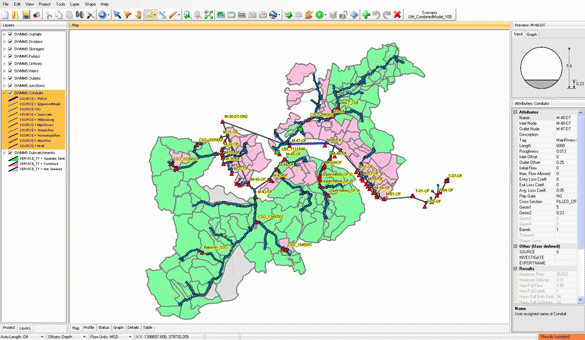Edgemont Reservoir Dam Assessment and Rehabilitation
Hazen and Sawyer serves as the lead engineer for the Edgemont Reservoir Dam Assessment and Rehabilitation project. The City of Hagerstown contracted Hazen to evaluate MDE Dam Safety Program concerns associated with potential seepage through the dam’s right abutment and observed concrete distress and movement associated with the dam’s concrete side channel chute spillway.
Dry Operation to Minimize Downstream Impact
While the dam was assessed and rehabilitated, the City of Hagerstown maintained the reservoir in an essentially dry condition. Hazen developed a phased Dry Operations Plan using several different Best Management Practices to minimize sediments being transported downstream.

Edgemont Reservoir Dam (also known as Warner Gap Hollow Dam) was originally constructed in the early 1900s as part of the water supply system for Washington County. The dam is classified as a Category I, or High Hazard, structure by the Maryland Department of the Environment (MDE) Dam Safety Program.
Hazen selected Triad Engineering Inc. to provide the required geotechnical exploration and engineering services. The team conducted a geotechnical field investigation of the overall dam and structural inspection of the dam’s concrete side channel chute spillway. The field investigation included soil borings within the embankment and right abutment along with rock corings in the underlying bedrock. Several corings within the side channel chute spillway were performed to evaluate steel placement, slab thickness, and the potential for voids under the slab. Options for addressing the structural distress within the spillway were developed by Hazen’s structural staff. This work included replacement of several sections of the slab and walls along with enhancements to the underdrain system.
As part of the overall rehabilitation effort, an evaluation of the dam’s ability to safely pass the required Design Storm was performed. In addition, a robust grouting program was developed to address the seepage within the right abutment and under the concrete side channel chute spillway. While the dam was assessed and rehabilitated, the City of Hagerstown maintained the reservoir in an essentially dry condition. In order to minimize the potential for downstream impacts, Hazen developed a phased Dry Operations Plan using several different Best Management Practices to minimize sediments being transported downstream.
Hazen is currently working with the City of Hagerstown and MDE to develop a detailed evaluation of alternative options to bring the dam into compliance with the requirements of the Dam Safety regulations.

Jeff Powers has served as a technical lead specializing in high hazard dam design and rehabilitation, river and floodplain hydraulic analysis, culvert and bridge analysis, and levee rehabilitation.
Related Topics:
Spillway Inspections
The project team conducted a geotechnical field investigation of the overall dam and structural inspection of the dam’s concrete side channel chute spillway.

Project Outcomes and Benefits
- Comprehensive evaluation of embankment seepage and development of a robust grouting plan.
- Spillway structural analysis including concrete corings and mapping of potential voids beneath the spillway slab.
- Detailed evaluation of the dam’s ability to pass the required Design Storm including an in-depth review of historical hydrologic calculations, PMP modeling using HMR-52, and full hydrologic and hydraulic analyses.
- Development of remedial design alternatives.
- Initiation of a Dry Operations Plan to minimize downstream impacts during the transitional, pre-rehabilitation phase
- Permitting and coordination with MDE Dam Safety Program.





















